Mobile apps market review: is the game worth the candle?
When you first think about the development of a mobile application and the subsequent entry into the market, of course, you need to assess the real volume of the market and its potential, that is, how much you can earn on such a laborious business as creating a mobile application. At first glance, it seems that everyone is just shouting about mobile marketing, but in reality even in the western market there is a lack of orderly information on the following points:
In 2012, the mobile application market was estimated at $ 53 billion, and the forecast for 2016 stated that the expected growth will be about $ 100 billion. These figures differ slightly from different researchers, but the obvious thing is that the mobile market is really big. Income developers get through internal in-app purchases, advertising inside applications, as well as collecting big data (big data). The most promising categories are social networks, performance, advertising services, as well as useful applications for various purposes. The fastest growing markets are Southeast Asia and Latin America.
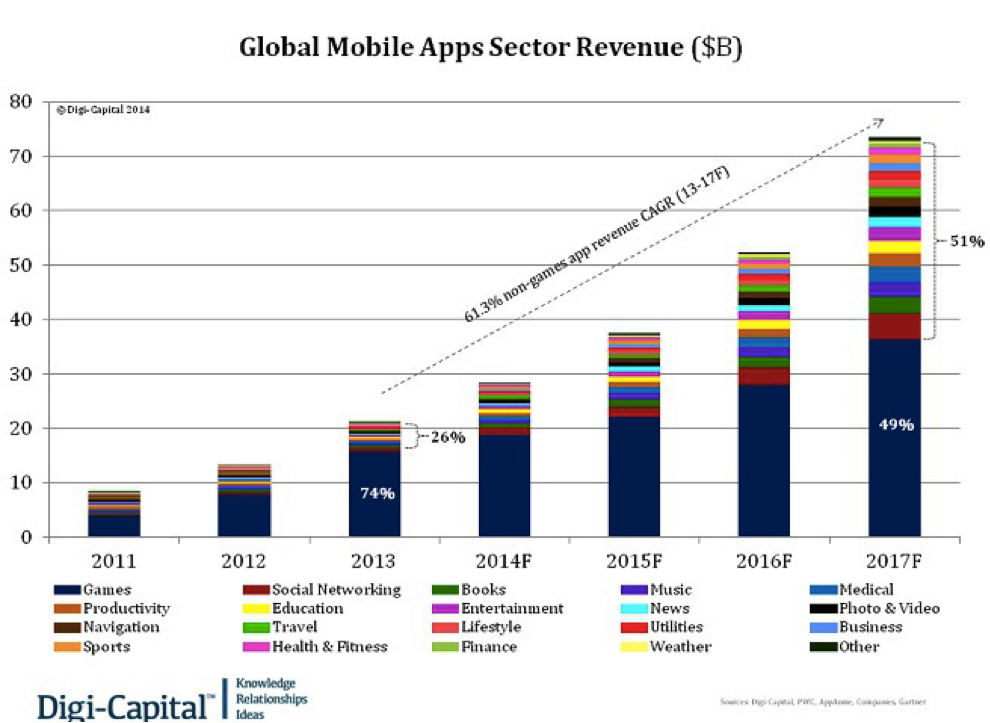
Source: Digi-Capital reflects substantial growth for the mobile application market. Image Credit: Digi-Capital
')
The approximate number of mobile application developers is 2.3 million, which means that one out of every eight developers in the world creates mobile applications. In 2013, Apple during the WorldWide Developer Conference announced that 1.25 million applications had already been published in the AppStore, which users downloaded 50 billion times, and the developers received an income of 5 billion dollars. The average developer income is shown in the table below.
Source: Forbes, How Much Average Apps Make? http://www.forbes.com/sites/tristanlouis/2013/08/10/how-much-do-average-apps-make/
It is expected that the jump in mobile applications will grow to 200 billion a year, and revenues in 2017 will be equal to 63.5 billion dollars. . Analytical forecasts show that the market value of mobile payments worldwide will grow from 235 billion dollars. in 2013 to 721.3 billion dollars. in 2017 . The main reason for the rapid growth of mobile markets is the unprecedented growth in sales of tablets, smartphones and other mobile devices.
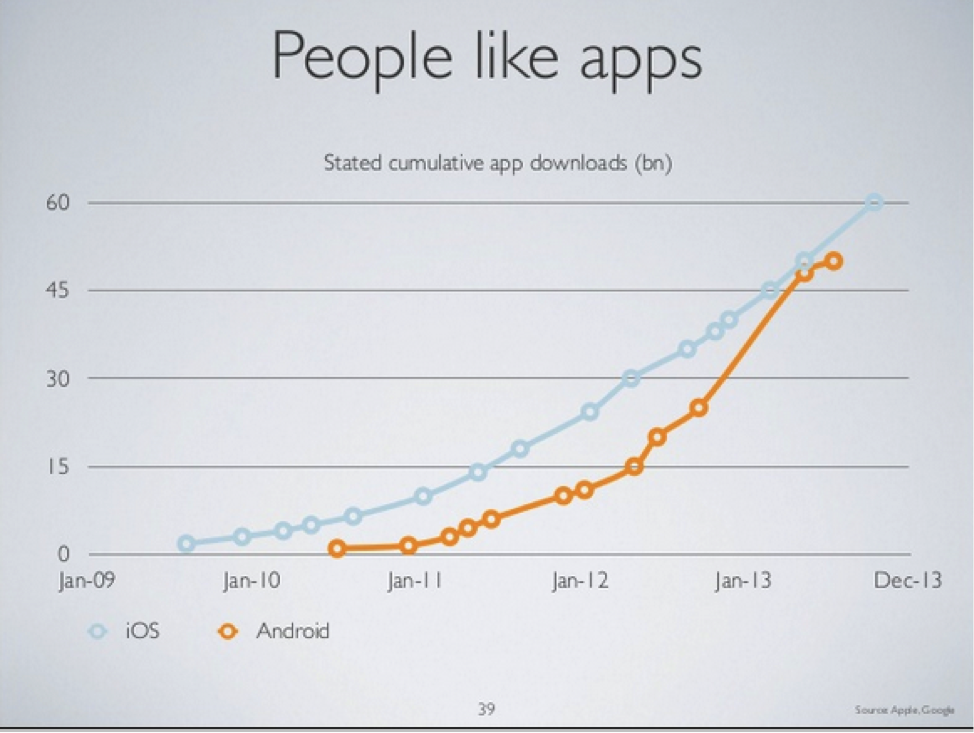
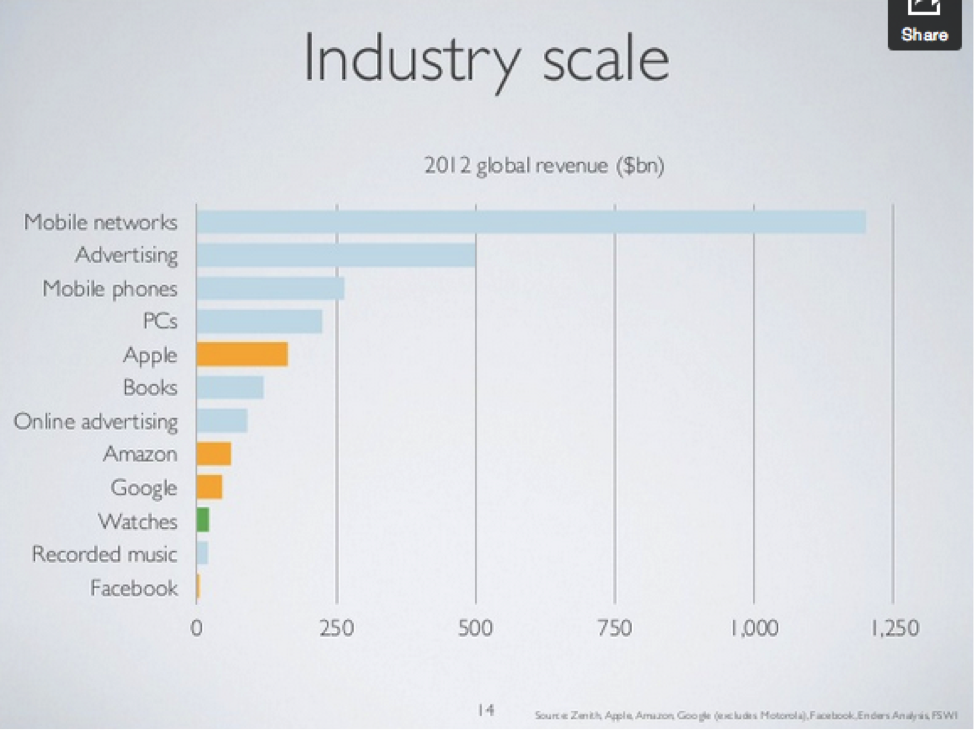
Source: Ben Evans, Mobiles Will Eat the World , 2013, http://ben-evans.com/benedictevans/2013/11/5/mobile-is-eating-the-world-autumn-2013-edition .
In the diagram above, we see distinct growth in all categories of applications. For mobile market researchers, it is obvious that mobile applications from marketing communications tools themselves turn into media distribution channels. Indicators such as coverage, contact frequency and retention rate in mobile applications are amazing . In the US, the use of mobile applications already exceeds all other channels of media consumption - it accounts for 82% of the total time.
At the moment, most mobile applications are B2C, because B2B applications are just starting to enter the market. But their potential growth is very high. Despite the different figures in the projected indicators of market dynamics, all researchers agree that the mobile application market is one of the most promising areas of digital.

In the US, 67% of users use a smartphone to go online every day, and most will never leave home without their phone. A similar increase in the use of smartphones is observed in Russia - even users with below-average incomes often choose a smartphone instead of a computer in order to always stay in touch with the world. Market research shows that about half of all mobile phone users have downloaded applications, and two thirds of them use them regularly. Most users of mobile applications are in the age range from 25 to 30 years old, married or married, live in suburban areas, and have a higher education. Thus, users of mobile applications in general are younger, more educated and have a higher income than users who do not use mobile applications.
Companies that want to build a mobile strategy can thus isolate a completely new type of consumer - constantly connected to the communication channels. Smartphone users prefer multitasking and mobility.
Users with whom you can contact via the mobile app are generally more involved in communicating with your brand as long as the communication channel is available to them, as is all the necessary information about the product.

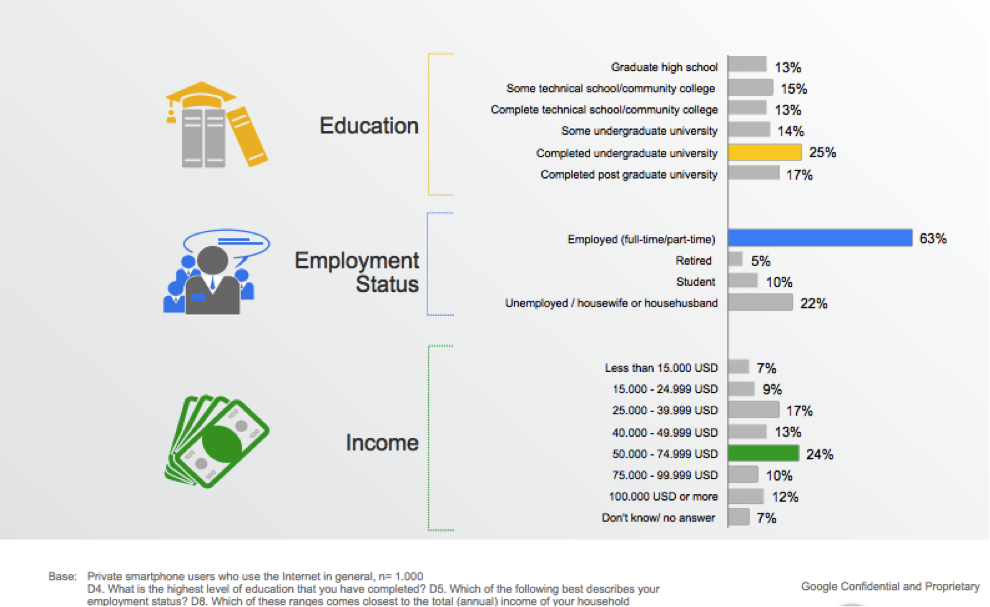
Mobile applications increase customer loyalty (especially in retail sales ). Loyal users more often download mobile applications and spend 2 times more time in them than on mobile versions of sites.

When you decide to create a mobile application, you need to know who to contact for help. The players in the mobile development market fall into 6 categories: consultants, product development specialists, digital agencies, mobile specialists, telecommunications companies and system integrators. According to Forrester's mobile research, the market for mobile professionals will grow to $ 32.4 billion. by the year 2018. The main part of the products offered are “builders” of mobile applications in various design and functionality. They offer three types of services: services for mobile engagement, management of mobile applications and devices, and development of mobile applications and services.
1. Mobile engagement services include demographic research, creating a mobile strategy, consulting on UX design, analytics, reworking business processes, updating back-end components, and system consolidation.
2. Management of mobile applications and devices is often paid for each unit.
3. Mobile application development includes the development and support of native or hybrid apps for tablets and smartphones along with the creation of a mobile site and responsive design. Existing APIs are used to connect to back-end components.
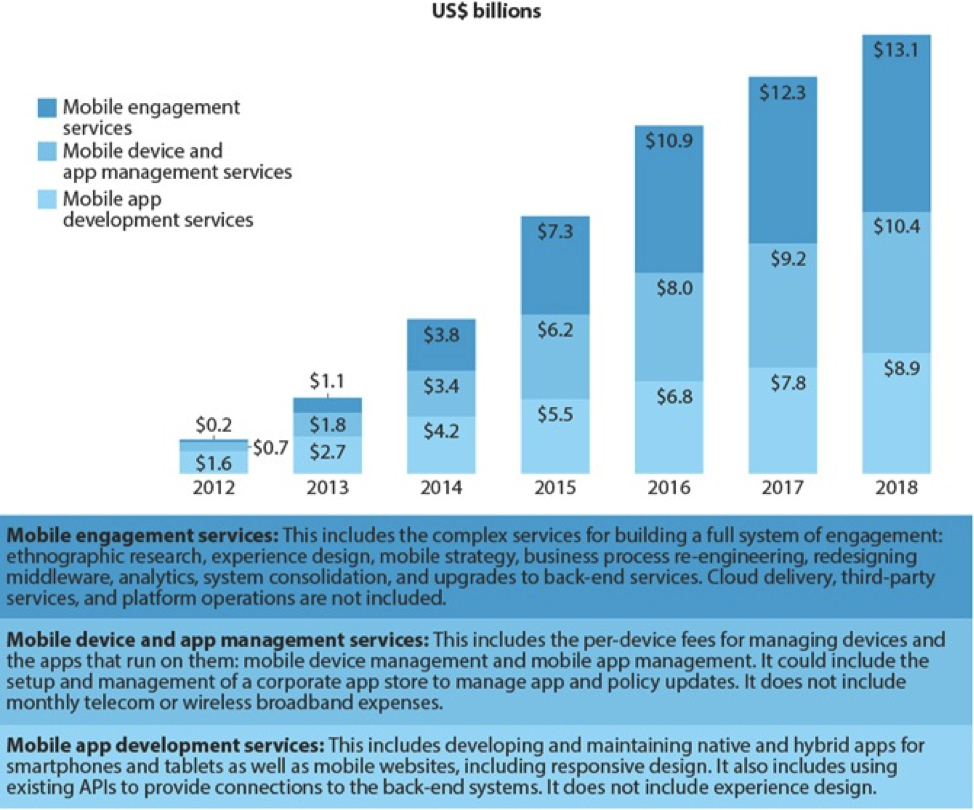 Source: Forbes, Mobile Engagement Providers $ 32.4 Billion Market By 2018, http://www.forbes.com/sites/forrester/2013/08/09/mobile-engagement-providers-will-be-a-new -32-4-billion-market-by-2018 / .
Source: Forbes, Mobile Engagement Providers $ 32.4 Billion Market By 2018, http://www.forbes.com/sites/forrester/2013/08/09/mobile-engagement-providers-will-be-a-new -32-4-billion-market-by-2018 / .
The release of the application is a difficult task for small and medium businesses, but the main problem is the constant support of the application. According to a Distimo study, only 2-3% of the most popular developers in the AppStore and Google Play are newbies, which perfectly reflects all the difficulties of creating a truly worthwhile, useful and exclusive application. The catch is that building an application and including all the necessary elements in it is only a small part of the work. After all, you need to think about such important things as registering a developer’s account on the AppStore and Google Play, sending the application to stores for review, hosting, regular notifications, involvement, support, fixing minor errors, adapting to new operating systems, etc.
A survey among 100 iOS, Android, and HTML5 developers shows that the average time to create the first version of a native mobile application is 18 weeks . This work includes tasks for back-end (data storage, use management, work with the server, data integration, push notifications and release of new versions) and front-end tasks (caching, synchronization, creating layouts, UI-design, UI- development and subsequent refinement).
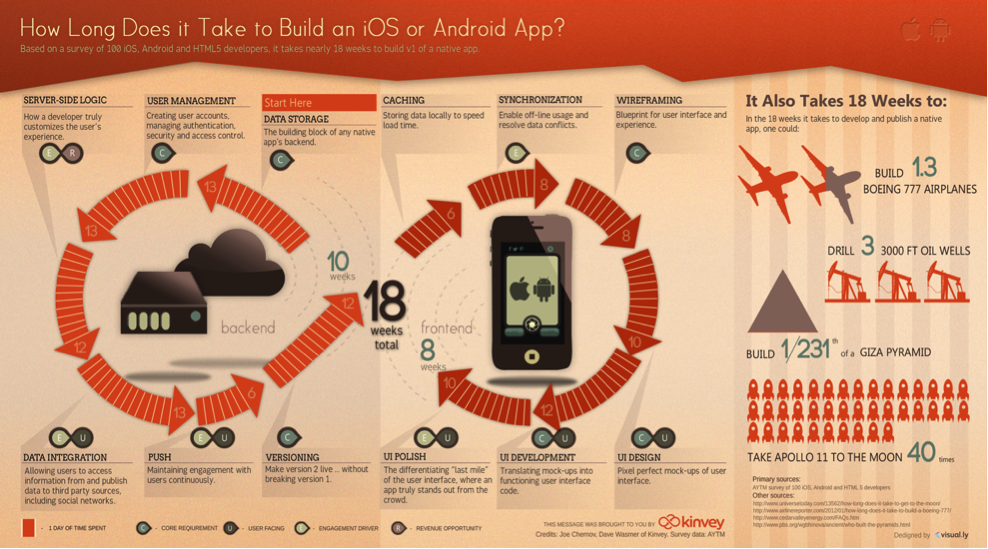
Source: visual.ly, How Long does it take to build an iOS or Android App? http://visual.ly/how-long-does-it-take-build-ios-or-android-app
When small and medium businesses, freelancers or bloggers decide to create a mobile application, they are likely to just google services for building template applications. Subscription plans cost from $ 10 to $ 1000 per month, while you do not need to acquire programming skills. At the same time, custom mobile applications that require months to develop, cost from $ 100,000 up to two million dollars, depending on the complexity of the application. To choose a specific option for the price is quite difficult, because The relative cheapness of self-made services for sample applications is due to poor design, poor product quality, problems with support and content updates, versions, etc., which is generally quite expensive.
Thus, large corporations can afford to build native applications with many features for an ideal user experience. But this does not mean that with a small budget there are no options for small and medium businesses.
Write your opinion in the comments.
- which companies can be considered key players in the global market for mobile applications;
- how big this market really is;
- how much can you earn on a mobile application;
- why your business generally needs mobile apps;
- where to start, if you do decide to develop.
How profitable can the mobile app market be?
In 2012, the mobile application market was estimated at $ 53 billion, and the forecast for 2016 stated that the expected growth will be about $ 100 billion. These figures differ slightly from different researchers, but the obvious thing is that the mobile market is really big. Income developers get through internal in-app purchases, advertising inside applications, as well as collecting big data (big data). The most promising categories are social networks, performance, advertising services, as well as useful applications for various purposes. The fastest growing markets are Southeast Asia and Latin America.

Source: Digi-Capital reflects substantial growth for the mobile application market. Image Credit: Digi-Capital
')
The approximate number of mobile application developers is 2.3 million, which means that one out of every eight developers in the world creates mobile applications. In 2013, Apple during the WorldWide Developer Conference announced that 1.25 million applications had already been published in the AppStore, which users downloaded 50 billion times, and the developers received an income of 5 billion dollars. The average developer income is shown in the table below.
Indicator / Company | Apple | Microsoft | |
Number of users (in million people) | 900 | 600 | 12 |
Number of applications (in thousands) | 800 | 1250 | 160 |
Number of developers (in thousands) | 150 | 235 | 45 |
Number of application downloads (billion times) | 48 | 50 | 65 |
Developer revenue (in millions of dollars.) | 900 | 5000 | 100 |
Average income per application | $ 1125 | $ 4,000 | $ 625 |
Average income per developer | $ 6,000 | $ 21,276 | $ 2,222 |
Source: Forbes, How Much Average Apps Make? http://www.forbes.com/sites/tristanlouis/2013/08/10/how-much-do-average-apps-make/
It is expected that the jump in mobile applications will grow to 200 billion a year, and revenues in 2017 will be equal to 63.5 billion dollars. . Analytical forecasts show that the market value of mobile payments worldwide will grow from 235 billion dollars. in 2013 to 721.3 billion dollars. in 2017 . The main reason for the rapid growth of mobile markets is the unprecedented growth in sales of tablets, smartphones and other mobile devices.


Source: Ben Evans, Mobiles Will Eat the World , 2013, http://ben-evans.com/benedictevans/2013/11/5/mobile-is-eating-the-world-autumn-2013-edition .
In the diagram above, we see distinct growth in all categories of applications. For mobile market researchers, it is obvious that mobile applications from marketing communications tools themselves turn into media distribution channels. Indicators such as coverage, contact frequency and retention rate in mobile applications are amazing . In the US, the use of mobile applications already exceeds all other channels of media consumption - it accounts for 82% of the total time.
At the moment, most mobile applications are B2C, because B2B applications are just starting to enter the market. But their potential growth is very high. Despite the different figures in the projected indicators of market dynamics, all researchers agree that the mobile application market is one of the most promising areas of digital.

Time spent using mobile apps
What audience can I target my mobile app for?
In the US, 67% of users use a smartphone to go online every day, and most will never leave home without their phone. A similar increase in the use of smartphones is observed in Russia - even users with below-average incomes often choose a smartphone instead of a computer in order to always stay in touch with the world. Market research shows that about half of all mobile phone users have downloaded applications, and two thirds of them use them regularly. Most users of mobile applications are in the age range from 25 to 30 years old, married or married, live in suburban areas, and have a higher education. Thus, users of mobile applications in general are younger, more educated and have a higher income than users who do not use mobile applications.
Companies that want to build a mobile strategy can thus isolate a completely new type of consumer - constantly connected to the communication channels. Smartphone users prefer multitasking and mobility.
Users with whom you can contact via the mobile app are generally more involved in communicating with your brand as long as the communication channel is available to them, as is all the necessary information about the product.


A demographic survey of users of mobile applications from Google
Mobile applications increase customer loyalty (especially in retail sales ). Loyal users more often download mobile applications and spend 2 times more time in them than on mobile versions of sites.

Indicators of the use of mobile applications in different countries of the world
What are the options for mobile development?
When you decide to create a mobile application, you need to know who to contact for help. The players in the mobile development market fall into 6 categories: consultants, product development specialists, digital agencies, mobile specialists, telecommunications companies and system integrators. According to Forrester's mobile research, the market for mobile professionals will grow to $ 32.4 billion. by the year 2018. The main part of the products offered are “builders” of mobile applications in various design and functionality. They offer three types of services: services for mobile engagement, management of mobile applications and devices, and development of mobile applications and services.
1. Mobile engagement services include demographic research, creating a mobile strategy, consulting on UX design, analytics, reworking business processes, updating back-end components, and system consolidation.
2. Management of mobile applications and devices is often paid for each unit.
3. Mobile application development includes the development and support of native or hybrid apps for tablets and smartphones along with the creation of a mobile site and responsive design. Existing APIs are used to connect to back-end components.
 Source: Forbes, Mobile Engagement Providers $ 32.4 Billion Market By 2018, http://www.forbes.com/sites/forrester/2013/08/09/mobile-engagement-providers-will-be-a-new -32-4-billion-market-by-2018 / .
Source: Forbes, Mobile Engagement Providers $ 32.4 Billion Market By 2018, http://www.forbes.com/sites/forrester/2013/08/09/mobile-engagement-providers-will-be-a-new -32-4-billion-market-by-2018 / .The release of the application is a difficult task for small and medium businesses, but the main problem is the constant support of the application. According to a Distimo study, only 2-3% of the most popular developers in the AppStore and Google Play are newbies, which perfectly reflects all the difficulties of creating a truly worthwhile, useful and exclusive application. The catch is that building an application and including all the necessary elements in it is only a small part of the work. After all, you need to think about such important things as registering a developer’s account on the AppStore and Google Play, sending the application to stores for review, hosting, regular notifications, involvement, support, fixing minor errors, adapting to new operating systems, etc.
A survey among 100 iOS, Android, and HTML5 developers shows that the average time to create the first version of a native mobile application is 18 weeks . This work includes tasks for back-end (data storage, use management, work with the server, data integration, push notifications and release of new versions) and front-end tasks (caching, synchronization, creating layouts, UI-design, UI- development and subsequent refinement).

Source: visual.ly, How Long does it take to build an iOS or Android App? http://visual.ly/how-long-does-it-take-build-ios-or-android-app
When small and medium businesses, freelancers or bloggers decide to create a mobile application, they are likely to just google services for building template applications. Subscription plans cost from $ 10 to $ 1000 per month, while you do not need to acquire programming skills. At the same time, custom mobile applications that require months to develop, cost from $ 100,000 up to two million dollars, depending on the complexity of the application. To choose a specific option for the price is quite difficult, because The relative cheapness of self-made services for sample applications is due to poor design, poor product quality, problems with support and content updates, versions, etc., which is generally quite expensive.
Thus, large corporations can afford to build native applications with many features for an ideal user experience. But this does not mean that with a small budget there are no options for small and medium businesses.
Write your opinion in the comments.
Source: https://habr.com/ru/post/291238/
All Articles